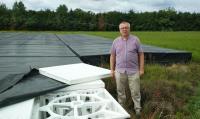A new concept for observing space objects

Researchers are working on new solutions that will facilitate the observation of space objects, photo Faculty of Electronics and Information Technology at WUT
Our researchers have created a solution that will not require the use of specialized transmitters. However, it will allow for quick and precise determination of the position of space stations, satellites, high-speed rockets or even junk collection.
A team led by Prof. Konrad Jędrzejewski, Faculty of Electronics and Information Technology, Warsaw University of Technology, observed the flight of the International Space Station (ISS) with the use of Polish receiving antennas of the international network of astronomical radio telescopes LOFAR (LOw Frequency ARray) and simple solutions based on commercially available commercial radio receivers. The precise results obtained in colaboration with researchers from the Space Research Center of the Polish Academy of Sciences allowed for the development of new methods of searching space, including the international system for tracking satellite motion measurements.
Promising first results
- The detection of very weak signals reflected from space objects is today one of the biggest challenges in the field of radiolocation signal processing - explains Prof. Konrad Jędrzejewski. - Very high speeds and gigantic distances make it very difficult to estimate the parameters of objects in orbit.
Currently, to track the movement of satellites, active radar methods are used, which are based on dedicated huge antennas, using very high powers of the transmitted signal. Classic measurements with the use of telescopes and measurements with the use of laser techniques are also used, for example at the Astrogeodynamic Observatory of the Space Research Centre of Polish Academy of Sciences in Borówiec near Poznań.
- Unfortunately, due to technological limitations, such a solution cannot be used during the day - points out Prof. Jędrzejewski. - The methods and algorithms in the field of passive radiolocation developed at our Faculty and the conducted preliminary experiments indicate that, as one of the first in the world, using passive radiolocation techniques we are able to effectively estimate the position and speed of space objects regardless of the time of day or prevailing conditions atmospheric.
What can be observed from Poland?
The first observations of the International Space Station with the use of radio telescopes that are part of the international LOFAR network (including the one located in Borówiec near Poznań) were carried out in 2020. Further observations were made with the use of two Polish LOFAR radio telescopes located in Borówiec (managed by Space Research Centre of Polish Academy of Sciences) and in Łazy near Kraków (owned by the Jagiellonian University). In the next experiments, carried out in December 2021, the infrastructure necessary to conduct such observations was simplified. This time, the measurements were performed using the LOFAR station in Borówiec and a commercial USRP radio signal receiver with a small antenna for several dozen zlotys located in Otwock, which surved the purpose of a reference signal receiver. The signal used in recent experiments to illuminate the International Space Station was the signal of the DAB + digital radio transmitter located at the Palace of Culture and Science in Warsaw.
It turned out that using the LOFAR radio telescope available in Poland, used on a daily basis for astronomical purposes, and a simple reference signal receiver, it is possible to build a passive radar system that is perfectly capable of observing objects located at low orbits in space as seen from Poland.
The researchers keep on working, and the world has already appreciated that
The discovery may soon find application also in the detection of threats flowing from space and arising in orbits around the Earth. Our researchers in collaboration with Space Research Centre of Polish Academy of Sciences, using the developed methods and algorithms, have also made observations of the movement of the smaller ENVISAT satellite and plan to observe even smaller objects. The results of the experiments carried out so far have already aroused the interest of the Polish Space Agency, as well as radiolocation specialists from around the world. The developed solutions and selected results of the experiments will be presented at one of the most important conferences of the radiolocation environment IEEE Radar Conference 2022 (RadarConf'22), which will be held on March 21-25, 2022 in New York.
Experts from Warsaw University of Technology have also developed a concept of a new antenna field, increasing the observation possibilities of objects located in low Earth orbits, in relation to the possibilities resulting from the properties of the antenna fields of the LOFAR station. The theoretical analyzes carried out in this respect are the basis for the application submitted to the National Center for Research and Development for the implementation of the project, under which new antenna fields are to be built: one at the Warsaw University of Technology airport in Przasnysz, and the other at the Astrogeordinamic Observatory of the Space Research Centre of Polish Academy of Sciences in Borówiec.
- Perhaps in a few years we will be able to accurately determine the position and speed of even very small space objects flying over Europe - says Prof. Jędrzejewski. - This may be the most effective protection against the increasingly real threats related to the number of objects placed in orbit and the so-called space junk.







